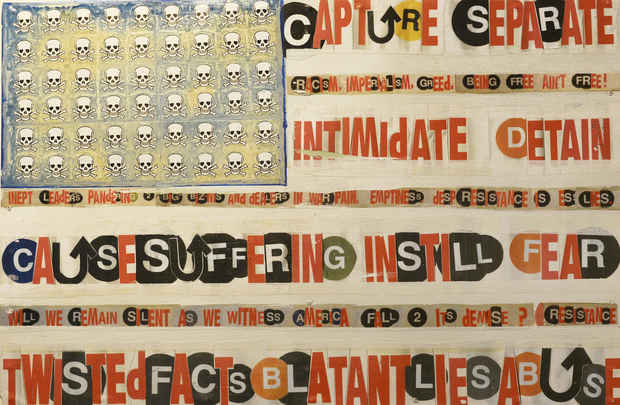“4 Those of Us Who Merely Tolerate ‘Civilization’…”
Van Der Plas Gallery

This event has ended.
Graffiti, a secret vice of fast-footed scofflaws artists, changing the skin of New York City into something that could be inscribed with personal messages. It isn’t exactly popular with landlords and the MTA.
But with all expressions of art, we find there is a difference; in destructive and substandard expressions we also witness greatness.
Working with Al Dìaz, Jean-Michel Basquiat first achieved fame as part of SAMO©… , which wasn’t any particular person or persons but a product. This enigmatic epigram began to appear in the cultural hotbed of the Lower East Side of Manhattan during the late 1970s.
Basquiat died in 1988; Al Dìaz went underground a few years later, to rise like a phoenix in 2016, pulling SAMO©… back up with him.
At the exhibition we can admire Dìaz’s new WET PAINT collages, including an American Flag made from WET PAINT signs retrieved from the subway. Dìaz has replaced the stars with skulls and arranged the composition on a metal sheet.
There are two small Richard Hambleton paintings in the exhibition, one an exquisite sunset in gold, somewhere in his native Canada.
Known for being the Shadow Man in the 1980s, and working at night with a black cape hiding his spray can and brush, Hambleton used bold black to create life-size graffiti silhouettes with exploding heads. He left his paintings behind alleyways or abandoned buildings. Some of his characters seemed to jump out right out from behind garbage cans.
Franc Palaia photographs in the exhibition show Hambleton’s shadow men when they were first created.
Scot Borofsky an artist originally from Brattleboro, VT, received his BA in painting from Rhode Island School of Design in 1981. Borofsky then moved to New York after receiving a Max Beckman memorial painting scholarship at the Brooklyn Museum. He created spray paintings near crime-filed public housing projects of the East Village neighborhoods. Here, his spray-painted enamel on treated linen constructions bring together influences from pre-Colombian design, ancient Chinese landscape painting, and African mask-making.
Bob Dombrowski, has been known for creating flat metal sculptures in the 1980s which were mounted to street light poles. In the exhibition there is a two-sided painted sheet metal sculpture. The metal is cut and painted in geometric shapes, with delicate contrasting colors on aging sheet metal referencing ancient Celtic Art. It’s one of the rare remaining examples of this type of early conceptual street art.
Jason McLean is a Brooklyn based Canadian artist; he is creating autobiographical imagery, through scavenged objects, and memory mapping. Jason McLean’s diverse art practice includes sculpture, sound works, zines, book works, mixed-media installations, correspondence art, curatorial explorations, puppets, and performance, but he is probably best known for his diaristic mapping and surreal drawings. Inspirations fueling his daily observations are relationships with local and visited environments. His works are often described as mental maps, where samplings of his daily observations are mashed-up into antiheroic, yet poignant combinations. The exhibition presents a large-scale acrylic painting on paper, luminous in color, of electric yellow and red, titled “Life Style of The Rich & Famous”.
Kevin Wendall, known for signing his paintings, “FA-Q, painted expressive faces which seemed to draw inspiration from underground comics, “Rat- Fink” bubblegum cards, Mad Magazine, and also African masks. He stated that Philip Guston’s work was his greatest inspiration from the modernists. “Primal Mask” is a naiveté portrait head reminiscent of the monstrous sculptures of the Toltecs.
At first glance, Alejandro Caiazza’s paintings seem whimsical and delightful, but often there is a deeper, darker side to his work. He creates elementary figures, skulls, clowns, and madmen. Inspired by the drawings of children, these often cruel characters are often deformed, absurd, and grotesque. Many of the paintings are inspired by feelings and daily life. Using various mediums such as paint and mixed media Caiazza’s style is art brut or neo-expressionism, with influences such as Jean Dubuffet, Jonathan Meese, Georg Baselitz, William de Kooning, Jean Michel Basquiat, and A.R. Penck.
Media
Schedule
from March 11, 2019 to April 07, 2019
Opening Reception on 2019-03-20 from 18:00 to 20:00